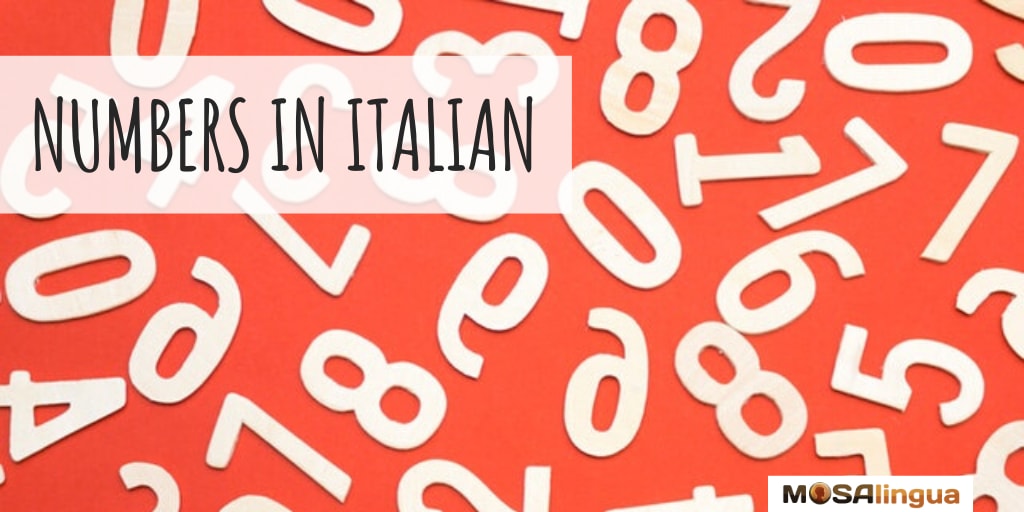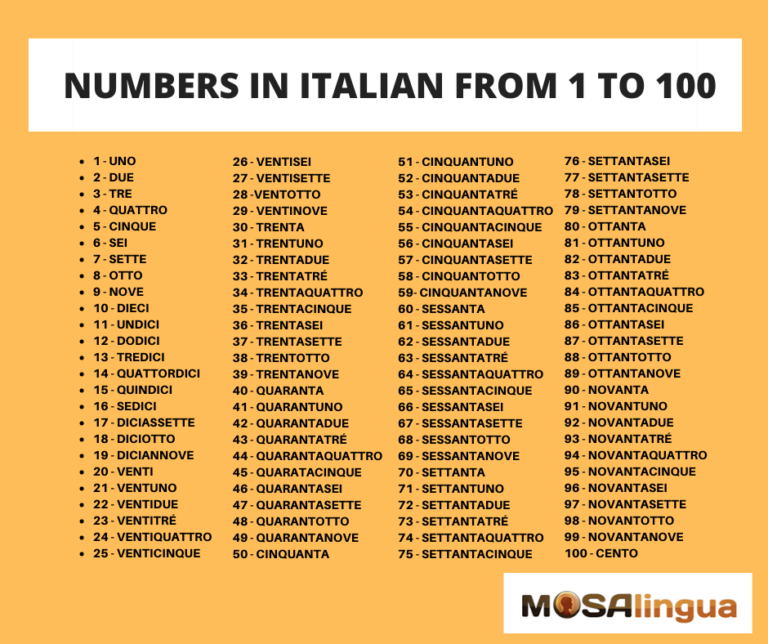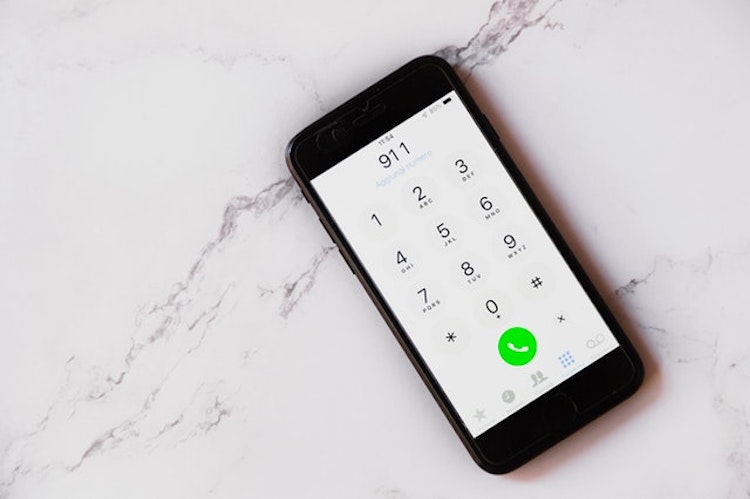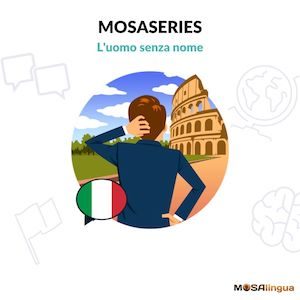You may already feel pretty comfortable with numbers in Italian, but just to be sure, try to answer all these questions: How old are you? What time is it? When is your birthday? If you had any trouble, that means you still have some work to do learning numbers in Italian! Studying them will also help you practice your pronunciation, so let’s get started!

Numbers in Italian: A Study Guide
A lot of students leave numbers for last because they don’t consider them as important as other aspects of the language.
Plus, studying numbers may not be as exciting or entertaining as studying other things. That’s why, with this article, we want to give you some fun and easy resources and techniques to learn numbers and their pronunciation. For now, we’ll focus on the cardinal numbers (one, two, three…).
We also encourage you to use the MosaLingua app to learn Italian and keep studying this amazing language.
Italian Numbers from 0 to 10
First off, in Italian, like in English, numbers from 0 to 10 have specific names. There’s no rule, so you just have to memorize them:
- Zero – zero
- One – uno
- Two – due
- Three – tre
- Four – quattro
- Five – cinque (it is important to get the pronunciation of this word right if you want to travel to the beautiful Cinque Terre region in Italy!)
- Six – sei
- Seven – sette
- Eight – otto
- Nine – nove
- Ten – dieci
Italian Numbers from 10 to 20
Italian numbers from 11 to 19 are all formed with the affix -dici. Between 11 and 16 the -dici goes at the end, and between 17 and 19 it goes at the beginning:
- Eleven – undici
- Twelve – dodici
- Thirteen – tredici
- Fourteen – quattordici
- Fifteen – quindici
- Sixteen – sedici
- Seventeen – diciassette
- Eighteen – diciotto
- Nineteen – diciannove
The peculiarity is that, for 17 and 19 we: (1) add an “-a-” between dici and the number; and (2) duplicate the first consonant of the number (diciassette, diciannove).
Incidentally, for Italian people, 17 is an unlucky number, whereas 3 is a lucky number!
Between 20 and 99, numbers are formed by combining the word for 20, 30, 40, 50, etc. and the number following it – the same as in English. With numbers ending in 1 and 8, drop the last vowel of 20, 30, 40, etc., and add uno for 1 and otto for 2. For example, the word for 20 is venti, so 21 is ventuno and 28 is ventotto.
Like numbers 1 through 9, each multiple of 10 has a specific name that has to be memorized.
Italian Numbers Up to 100
- Twenty – venti
- Twenty-one – ventuno
- Twenty-two – ventidue
- Twenty-three – ventitré
- Twenty-eight – ventotto
- Thirty – trenta
- Thirty-one – trentuno
- Thirty-two – trentadue
- Thirty-eight – trentotto
- Forty – quaranta
- Forty-one – quarantuno
- Forty-three – quarantatré
- Forty-eight – quarantotto
- Fifty – cinquanta
- Sixty – sessanta
- Seventy – settanta
- Eighty – ottanta
- Ninety – novanta
- One hundred – cento
Right-click the cheat sheet below if you want to save it and study your Italian numbers 1 – 100.
How to Pronounce Numbers in Italian
To learn how to say numbers in Italian, as with any other word, it’s very useful to listen to recordings of native Italian speakers, for example podcasts in Italian. This will not only help you to improve your pronunciation, but also familiarize your ear to new sounds and help you learn new words.
Forvo is another useful tool to practice pronunciation. You can listen to audio recordings by native Italian speakers, and record your own voice so you can check your pronunciation after.
And last, but not least, you’ll find videos about Italian grammar and pronunciation on our YouTube channel.
Uses of Italian Numbers
All the numbers we’ve talked about so far are cardinal numbers, as opposed to ordinal numbers (e.g. first, second, third).
In Italian, like in English, cardinal numbers go between the verb and the noun. For example:
- Voglio due mele: I want two apples
- La maglietta costa 30 euro: The t-shirt costs 30 euros
But not everything is the same. There are some differences between the position of numbers in Italian and English sentences:
→ When we talk about length, depth, height, etc. in Italian, the number goes after the corresponding adjective. For example:
- Il soffitto di casa mia è alto 5 metri: The ceiling in my house is 5 meters high.
- Quell’armadio è alto 2,5 metri e largo 90 centimetri: This closet is 2.5 meters tall and 90 cm wide.
→ When referring to ages 11 and up, use the suffix –enne. For example:
- Paola non è ancora diciottenne: Paola is not yet eighteen.
- I trentenni usano sempre di più le nuove tecnologie: 30-year-olds use more and more new technologies every day.
→ When referring to centuries in Italian, we use ordinal numbers. However, if you want to talk about a specific period of time from the 13th century onward, Italian has its own way, based on cardinal numbers.
| Century | Period | Years |
| XIII | il Duecento | 1201-1300 |
| XIV | il Trecento | 1301-1400 |
| XV | il Quattrocento | 1401-1500 |
| XVI | il Cinquecento | 1501-1600 |
| XVII | il Seicento | 1601-1700 |
| XVIII | il Settecento | 1701-1800 |
| XIX | l’Ottocento | 1801-1900 |
| XX | il Novecento | 1901-2000 |
Italian Numbers in Context
When you study a foreign language, it’s not enough to just learn words, expressions, and verb tenses. You also need to know how to use everything you learn in the right contexts. In this section, you’ll see how numbers are used in different situations, like giving the time or asking for prices.
Telling time in Italian
There are two ways of saying the time in Italian: using the 12-hour or the 24-hour system.
When speaking:
- Che ore sono?: What time is it?
- Sono le cinque e dieci: It’s ten past five.
You might have noticed that in Italian we ask “What times are they?” plural, instead of “What time is it?” like in English.
There are some more examples in the table below:
| Time | Italian Constructions | Translation |
|---|---|---|
| 13:00 (1:00 p.m.) | È l'una | It's one o'clock |
| 17:00 (5:00 p.m.) | Sono le cinque Alle cinque spaccate (informal) Alle quattro in punto | It's five o'clock It's five on the dot It's five sharp |
| 17:10 (5:10 p.m.) | Sono le cinque e dieci | It's ten past five |
| 17:15 (5:15 p.m.) | cinque e quindici cinque e un quarto | five fifteen quarter past five |
| 17:30 (5:30 p.m.) | cinque e trenta cinque e mezzo/a | five thirty |
| 17:45 (5:45 p.m.) | cinque e quarantacinque cinque e tre quarti (hour+1) sei meno un quarto | five forty-five quarter to six |
| 17:50 (5:50 p.m.) | Sono le cinque e cinquanta (hour+1) sei meno dieci Mancano dieci alle sei (hour+1) | It's five fifty It's ten to six |
| 0:00 (12:00 a.m.) | mezzanotte | midnight |
| 12:00 (12:00 p.m.) | mezzogiorno | noon |
When in doubt, just use the “official structure,” which is easier. Just say:
Le + time from 1 to 24 + e + minutes
Examples:
- Il treno parte alle quindici e venti minuti: The train leaves at three twenty.
- L’aereo atterra alle diciannove e dieci minuti: The plane lands at seven ten.
Dates in Italian
In English, ordinal numbers are used to talk about days of the month. In Italian, cardinal numbers are used, except for the first day of the month, in which case we use “primo.”
Examples:
- Il mio compleanno è il 26 marzo (ventisei): My birthday is March 26th
- Oggi è il 17 settembre (diciassette): Today is September 17th
- Il 1 gennaio è il mio onomastico (primo): January 1st is my name day
Prices in Italian
In both English and Italian, prices are indicated in a very similar way:
- 0,05€: cinque centesimi (five cents)
- 3,10€: tre euro e dieci centesimi (three euros and 10 cents)
We would like to finish this article with a famous Italian proverb that might help you remember some numbers:
“Non c’è due senza tre, il quattro vien da sè.”
It’s normally found shortened to “Non c’è due senza tre,” and it literally means, “There is no two without three, four comes by itself,” which equals the English expression, “Good things come in threes.”
To learn more about Italian numbers and their pronunciation, check out all of our online Italian resources.
Bonus: Audio Series for Learning Italian
If you love podcasts and TV shows, don’t forget to check out our original series for learning Italian! It’s an exciting story full of mystery that will help you improve your listening skills, pronunciation, vocabulary and Italian grammar. Not bad, right? Try MosaSeries Italian now!
Related posts:
Start improving your Italian today
Good news: we can help!
More good news: you can get started for free! With your free trial, you can test drive the most effective method for learning Italian for the next 15 days!
Vocabulary flashcards, videos with subtitles, audiobooks, articles adapted to your level – with MosaLingua Premium (Web & Mobile), you’ll have access to all this and more. Get started right now. It’s free—and risk-free—to try!








Comments